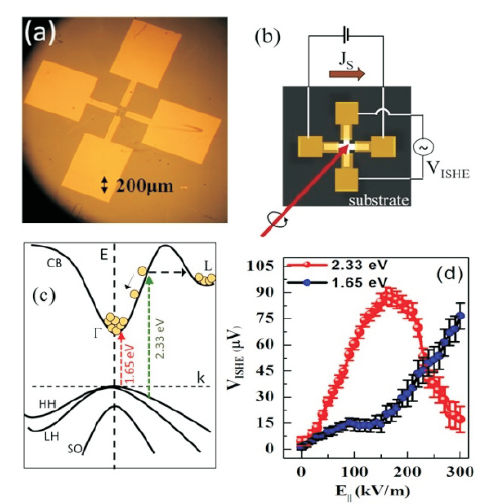|
Major Research Areas
R&D on spin-photonic devices
Development of GaAs based spin-Hall
devices with low power consumption
Spin-photonics is one of the frontline research area where a
lot of exotic developments are currently being made. For a
long time, inclusion of electronic spin degree of freedom with
charge have been aimed for improving the functionality of
semiconductor devices. One example is a spin-Hall device,
which generates electrical voltage corresponding to the
degree of circular polarization of incident light. It works on
the principle of Inverse Spin Hall Effect (ISHE), where
generation of transverse electrical voltage occurs as a
function of photo injected spin current. Traditionally, near
band edge lasers (Eex ~1.5 eV) are used to orient electronic spin ex
in à valley of conduction band of GaAs. A spin current and
subsequently a transverse electrical voltage (VISHE ) are ISHE
thereafter generated because of ISHE. Though such devices
are fast, compact, operate at room temperature and can be
integrated into existing optoelectronics platform, a low
signal-to-noise-ratio (SNR) is a major bottleneck. Efforts are
being made worldwide for enhancing the signal strength of
spin-Hall devices. The magnitude of VISHE depends critically ISHE
on a parameter called spin Hall angle (ãSH ). A small value of ãSH
in GaAs is the limiting factor for generating VISHE with large ISHE
SNR. It is realized that the L-valley of GaAs has two orders
larger value of ãSH as compared to Ã-valley due to a large SH
contribution of higher lying p-orbitals. Owing to this,
attempts are being made to involve the spin polarized
electrons in L-valley.

agram to show ISHE experiments, (c) band
structure of GaAs to show optical excitation at two energy
and, (d) plot of V versus appied bias at the two values of ISHE
excitation energy.
An indirect excitation of electrons to L-valley is not favorable
because of the momentum selection rules. Thus, the
application of high electric field is sought to initiate the intervalley
electron transfer, which enhances the magnitude of
VISHE significantly. However, it worsens SNR due to excessive ISHE
Joule heating. Though a large value of VISHE is desired, it ISHE
should be achieved preferably at low bias. Development of
spin-photonic devices have been carried out in our lab for the
past ten years where systematic efforts are put for enhancing
the strength of ISHE signal in high crystalline quality GaAs.
By utilizing optically injected hot-electrons at 2.33 eV, a spin-
Hall device is recently demonstrated by us that can provide
high VISHE at relatively low bias. The devices consume less ISHE
power and yield better signal-to-noise ratio.
For this work, 1 ìm thick high crystalline quality n-GaAs
epitaxial layers are grown by MOVPE technique. A Hall bar
type structure is fabricated by using mask-less
photolithography, chemical etching and Ohmic contact
metallization as shown in Figure L.13.1(a). The laser beam of
~50 μm diameter is focused at the center of the sample, whose
degree of circular polarization is modulated as shown in
Figure L.13.1(b). Subsequently, longitudinal electric field
(E ) is applied and VISHE is measured for the two values of || ISHE
optical excitation energy as shown in Figure L.13.1(c). In
particular, spin polarized hot electrons are injected in GaAs at
2.33 eV. It leads to a steady state electron accumulation in L
valley. By involving simultaneous energy, spin and inter
valley relaxation processes, it is estimated that nearly 1%
electrons are accumulated in L-valley, and about 40% of them
are spin polarized. A monotonous rise of VISHE is seen with ISHE
electric field, which starts to fall beyond a critical electric
field as shown in Figure L.13.1(d). A rapid increase in the
signal magnitude is observed at lower electric field at 2.33 eV
corresponding to a larger magnitude of ã in L-valley. From a SH
careful comparison between the two cases, it can be
appreciated that the same maximum magnitude (~80 ìV) of
VISHE can now be achieved at half the applied electric field. ISHE
Further, the power consumption and SNR improves by 2.5
and 1.5 times, respectively. One of the possible reasons
behind such reduction in power consumption is the optical
excitation of spin polarized hot electrons in the L-valley.
These findings are highly encouraging for the development of
next generation spin-optoelectronic devices. For more details
please see Mudi et al., Phys. Status Solidi, RRL, 14, 2000097
(2020).
|













